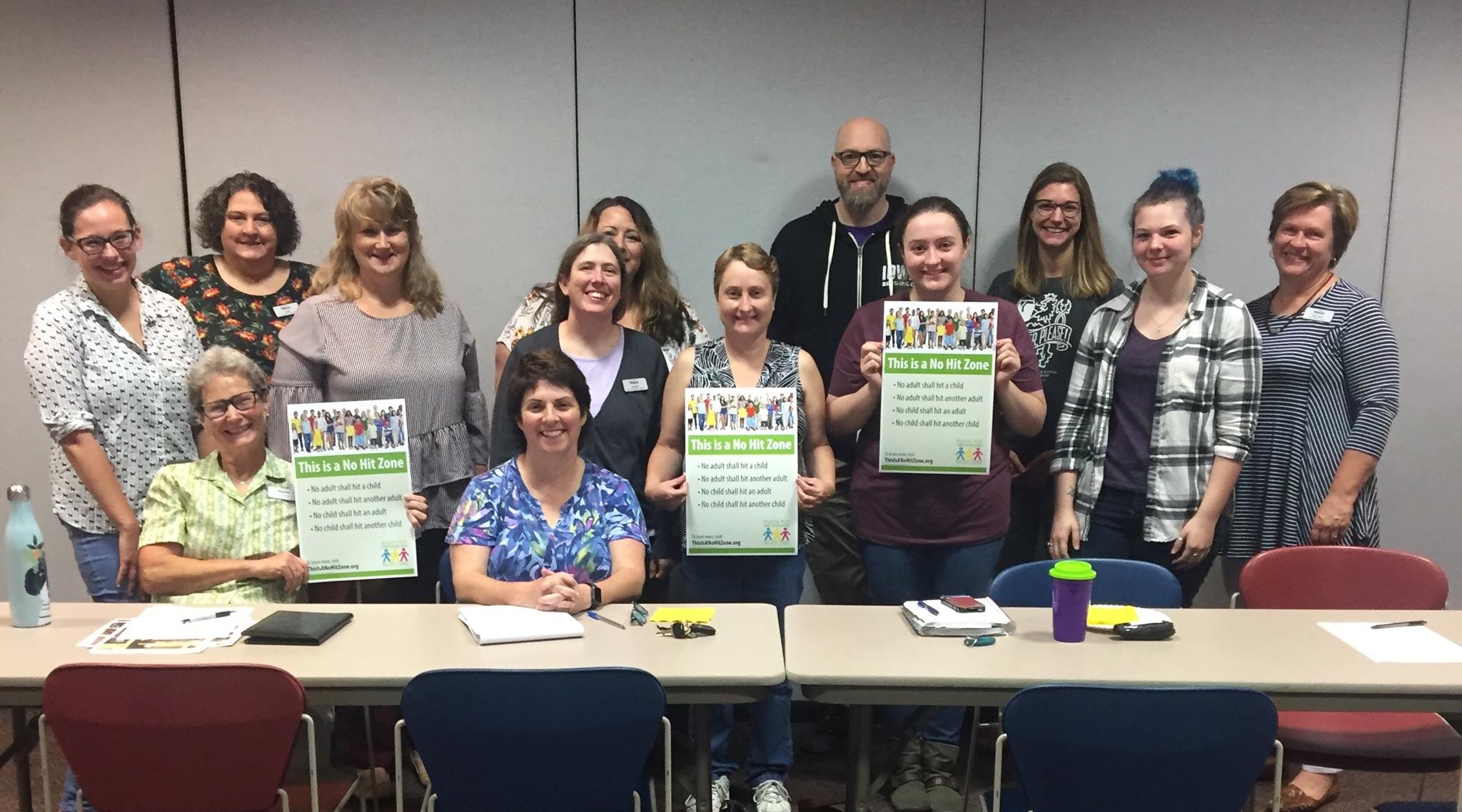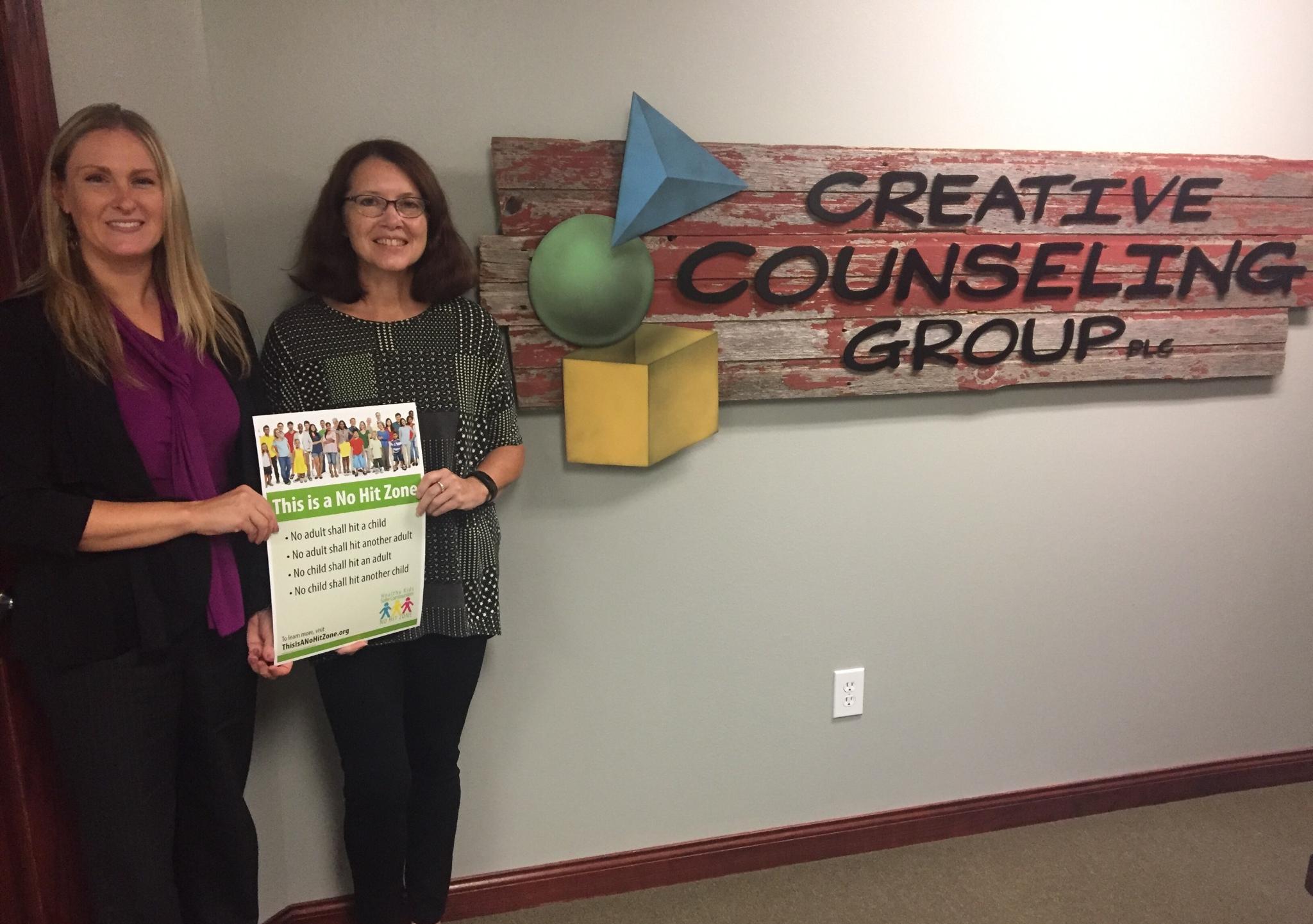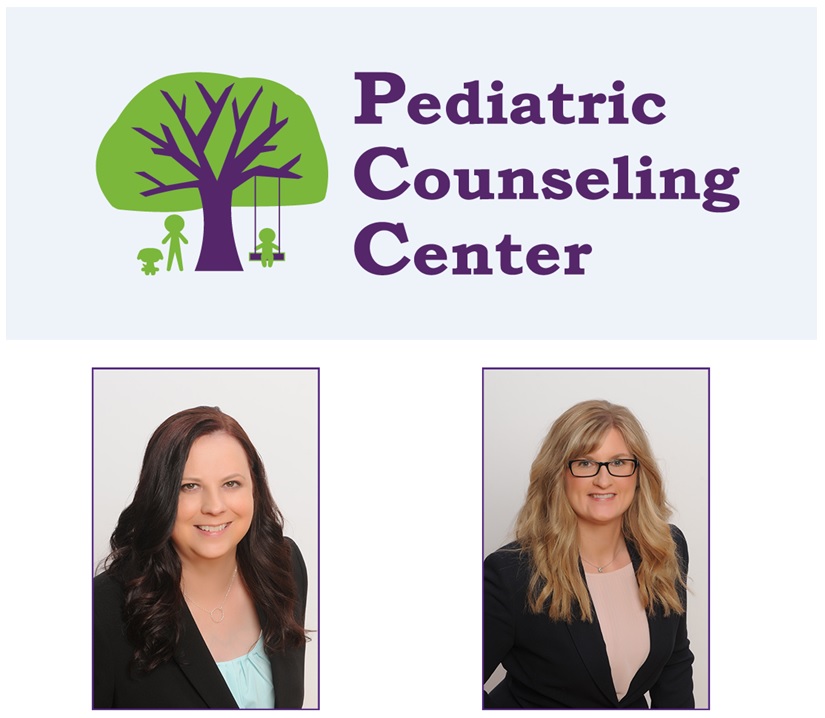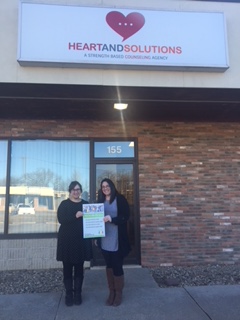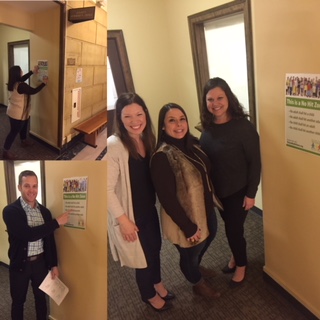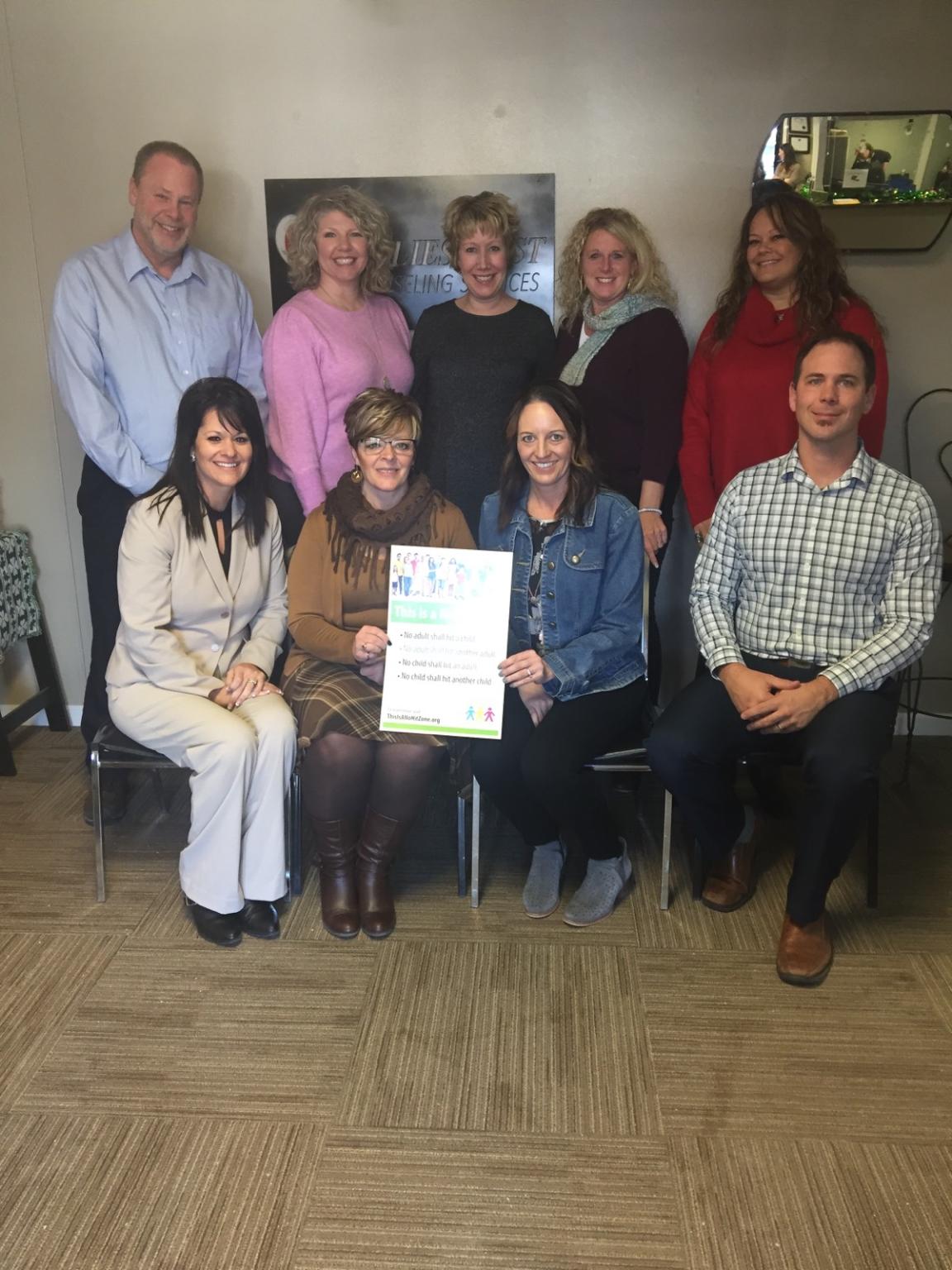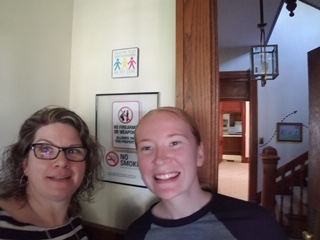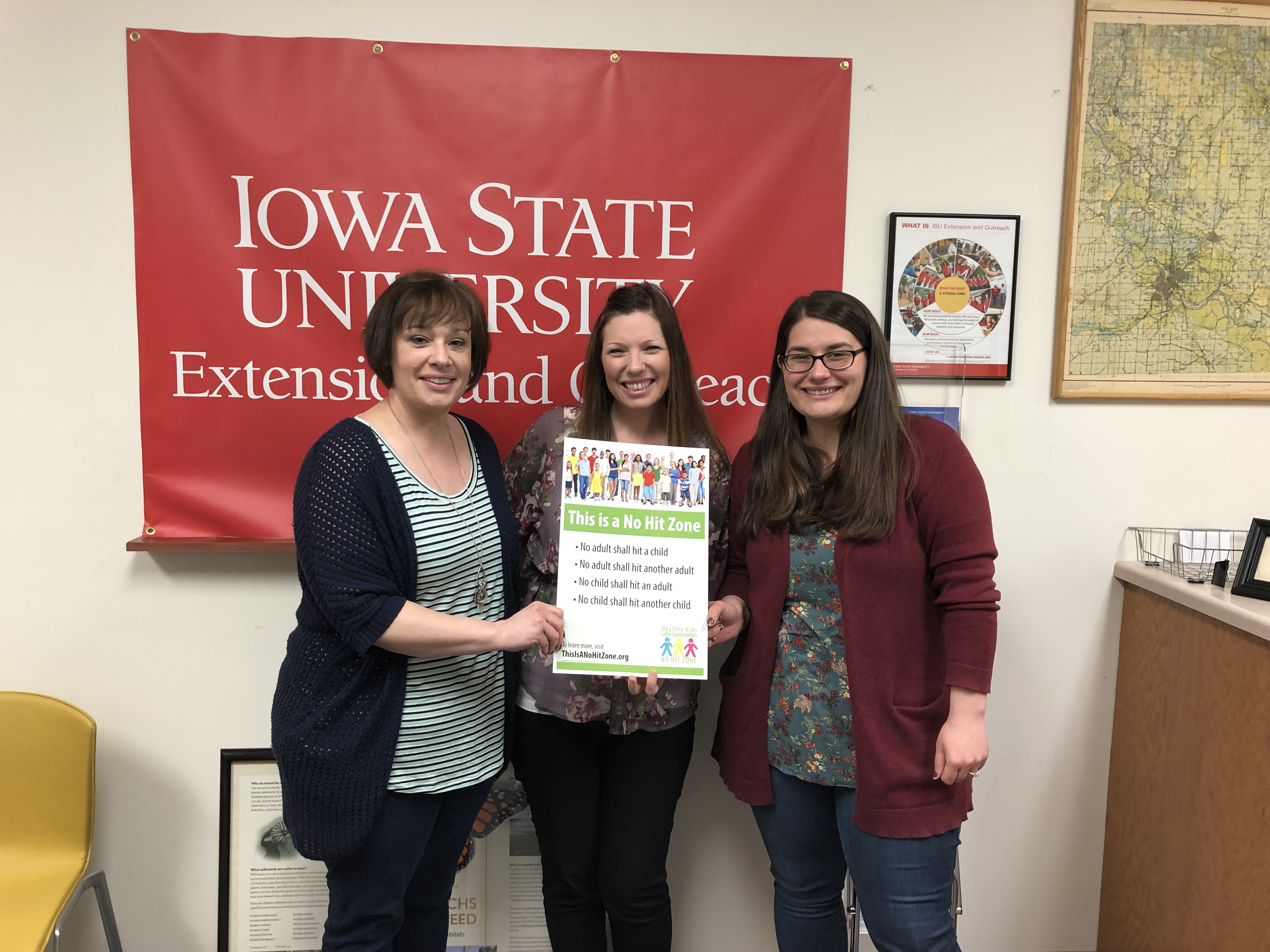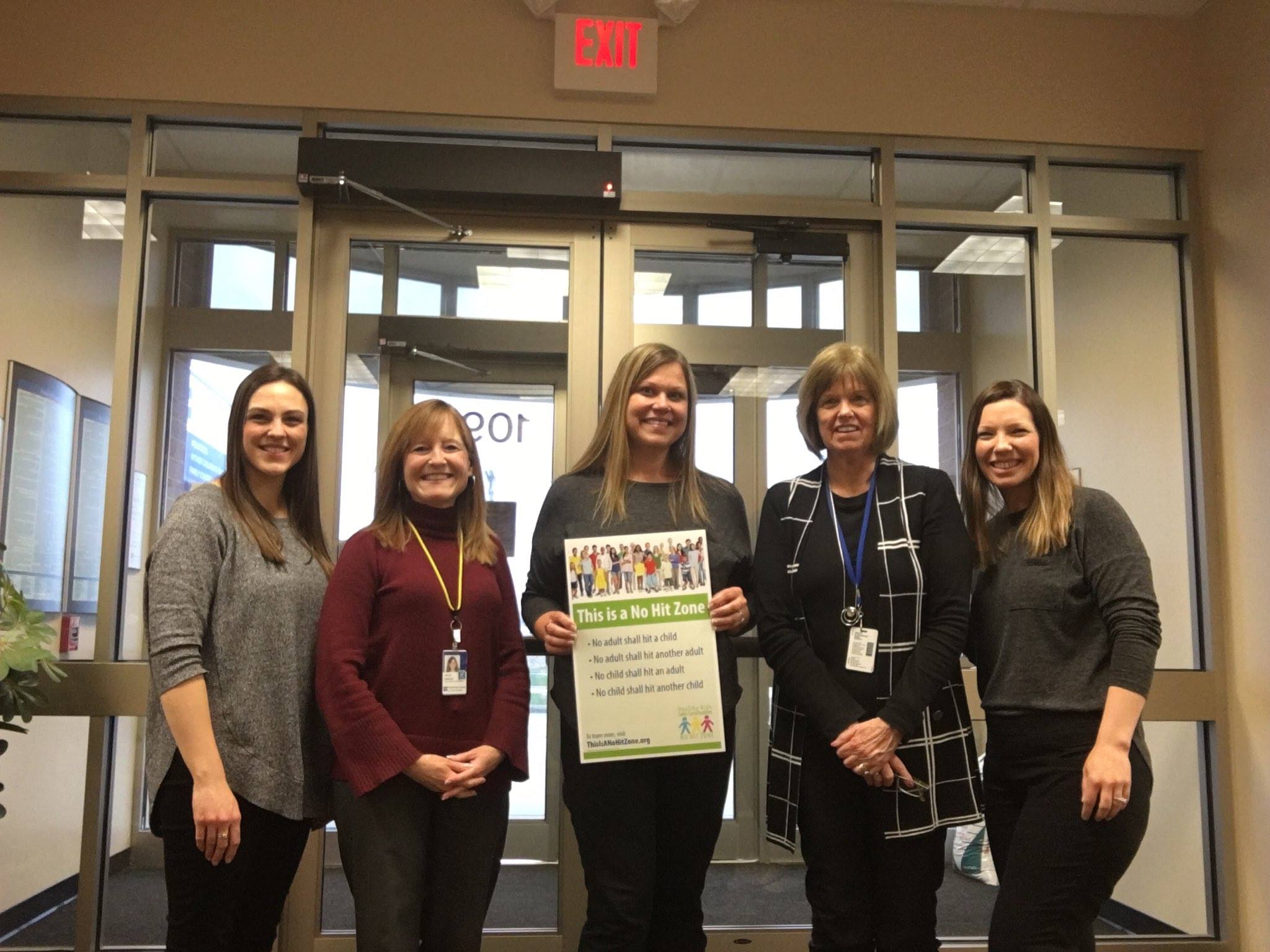IAPSAC has written a white paper on corporal punishment and is endorsing the program No Hit Zone. IAPSAC will recruit community partners across the state of Iowa to participate in the No Hit Zone Program. A No Hit Zone is an environment that supports a culture of safety and health where:
• No adult shall hit another adult
• No adult shall hit a child
• No child shall hit an adult
• No child shall hit another child
Marion Public Library in Marion, IA was the first community partner that IAPSAC recruited to become a No Hit Zone.
Marion Public Library became a No Hit Zone on September 1st, 2018.
|
UnityPoint Health St. Luke’s Hospital |
||
If you have any questions about the No Hit Zone initiative or would like to get involved,
please visit the No Hit Zone website or contact IAPSAC.
Corporal Punishment Position Paper
June 2018
Iowa Professional Society on the Abuse of Children (IAPSAC)
1095 N. Center Point Road
Hiawatha, IA 52233
The Iowa Professional Society on the Abuse of Children presents the following positions
- IAPSAC recommends corporal punishment and physical discipline techniques are eliminated in Iowa.
- IAPSAC recommends that community partners educate families about alternative techniques for discipline.
- IAPSAC recommends that community partners engage in methods to end corporal punishment and physical discipline.
- IAPSAC will endorse the program No Hit Zone and recruit community partners to participate in the No Hit Zone program.
Introduction
The Iowa Professional Society on the Abuse of Children (IAPSAC) was established in January of 2012 as a state chapter of the American Professional Society on the Abuse of Children (APSAC).
The mission of APSAC is: “To improve society’s response to the abuse and neglect of its children by promoting effective interdisciplinary approaches to identification, intervention, treatment and prevention of child maltreatment.”
The goals of IAPSAC are to:
- Promote collaboration among all disciplines working in the area of child protection.
- Promote education on maltreatment to professionals and community members who have contact with children.
- Promote research on child abuse and neglect in the areas of prevention, identification, intervention and treatment.
- Promote appropriate and effective services for children and families who have experienced child maltreatment.
Background
- Corporal punishment has been associated with increased violence in children and emotional disorders (Durrant and Ensom, 2012; Straus et al, 2013; Gershoff and Grogan-Kaylor, 2016).
- Research shows that physical discipline is associated with increases in delinquency, antisocial behavior and aggression in children as well as decreased the quality of the parent-child relationship (Gershoff 2008).
- If an adult hits another adult, it is considered a crime (assault), yet adults can physically punish children by hitting and it is not considered a crime (assault).
Definitions
- Physical discipline is defined as the use of physical force with the intention of causing a child to experience bodily pain or discomfort, so as to correct or punish the child’s behavior.
- Physical discipline includes spanking, hitting, pinching, squeezing, paddling, whipping/whupping, swatting, smacking, slapping, washing a child’s mouth with soap, making a child kneel on painful objects and forcing the child to stand or sit in painful positions for long periods of time.
- In Iowa, physical abuse is defined as any non-accidental physical injury, or injury which is at variance with the history given of it, suffered by a child as the result of the acts or omissions of a person responsible for the care of the child.
- Corporal punishment is defined as punishment that involves hitting someone.
Statistics
- As of May 2016, 49 countries worldwide have prohibited all corporal punishment of children.
- In the United States, 65% of adults approve of physical punishment and 50% of families use physical discipline (Gershoff 2008).
- Physical discipline is legal in schools in 19 states in the United States (Gershoff and Font, 2016).
American Academy of Pediatrics (AAP)
The American Academy of Pediatrics issued a policy statement in 1998 in regard to parental discipline of children and guidelines for effective discipline. The AAP does not recommend corporal punishment or physical discipline due to the negative consequences of corporal punishment and the fact that it is no more effective than other approaches used to manage undesired behavior in children.
Spanking in children under age 18 months increases the chance of physically injuring a child. Repeated spanking may increase agitation and aggressive behavior in children. Spanking and threats of spanking can alter the parent-child relationship.
The AAP recommends that a developmental approach to discipline is used and that pediatricians have an important role in encouraging and assisting parents in developing appropriate methods of discipline.
American Professional Society on the Abuse of Children (APSAC)
APSAC is the leading national organization that supports professionals serving children and families who are affected by child maltreatment. APSAC published a position paper on corporal punishment of children in July 2016. APSAC has called for the elimination of all forms of corporal punishment and physical discipline in all environments.
APSAC recommends that professionals educate the community about the harms of corporal punishment, age-specific expectations for child behavior and development and provide suggestions for positive parenting approaches that use non-physical forms of child guidance.
American Psychoanalytic Association (APsaA)
The APsaA published a position statement about physical/corporal punishment in 2013. APsaA recommends that alternative methods of discipline be used rather than corporal punishment. APsaA recommends that discipline should enhance a child’s ability to develop healthy emotional lives, tolerate frustration, regulate internal tensions and behave in socially acceptable ways.
The APsaA recommends that education, legislation and research are the three interventions needed for prevention of physical punishment in children. APsaA recommends education for parents, caregivers, educators, clergy, legislators and the general public, legislation to protect children and research about alternative methods of discipline and managing behaviors.
Centers for Disease Control (CDC)
The CDC has a policy asserting that physical punishment is child abuse and that it should be prohibited (Fortson et al, 2016). This position comes in part due to the increased violence and emotional disorders that occur in children who have experienced corporal punishment.
Adverse Childhood Experiences; CDC-Kaiser ACE Study
Childhood experiences, both positive and negative, have a tremendous impact on future violence victimization and perpetration, and lifelong health and opportunity. As such, early experiences are an important public health issue. Much of the foundational research in this area has been referred to as Adverse Childhood Experiences (ACEs).
Adverse Childhood Experiences have been linked to risky health behaviors, chronic health conditions, low life
potential, and early death.
Adverse Childhood Experiences (ACEs) are categorized into three groups: abuse, neglect, and family/household challenges.
Abuse
- Emotional abuse: A parent, stepparent, or adult living in your home swore at you, insulted you, put you down, or acted in a way that made you afraid that you might be physically hurt.
- Physical abuse: A parent, stepparent, or adult living in your home pushed, grabbed, slapped, threw something at you, or hit you so hard that you had marks or were injured.
- Sexual abuse: An adult, relative, family friend, or stranger who was at least 5 years older than you ever touched or fondled your body in a sexual way, made you touch his/her body in a sexual way, attempted to have any type of sexual intercourse with you.
Household Challenges
- Mother treated violently: Your mother or stepmother was pushed, grabbed, slapped, had something thrown at her, kicked, bitten, hit with a fist, hit with something hard, repeatedly hit for over at least a few minutes, or ever threatened or hurt by a knife or gun by your father (or stepfather) or mother’s boyfriend.
- Household substance abuse: A household member was a problem drinker or alcoholic or a household member used street drugs.
- Mental illness in household: A household member was depressed or mentally ill or a household member attempted suicide.
- Parental separation or divorce: Your parents were ever separated or divorced.
- Criminal household member: A household member went to prison.
Neglect
- Emotional neglect: No one in your family helped you feel important or special, you didn’t feel loved, people in your family didn’t look out for each other and you didn’t feel close to each other, and your family was not a source of strength and support.
- Physical neglect: There was no one to take care of you, protect you, and take you to the doctor if you needed it, you didn’t have enough to eat, your parents were too drunk or too high to take care of you, and you had to wear dirty clothes.
Conclusion
Research has shown that corporal punishment and physical discipline are detrimental to the physical, social and emotional health of children. The Adverse Childhood Experience (ACES) studies show that ACES affect children throughout their lives including risky health behaviors, chronic health conditions, low life potential, and early death. IAPSAC would recommend that corporal punishment and physical discipline be eliminated in Iowa. IAPSAC will engage community partners to support this recommendation. IAPSAC supports implementing the No Hit Zone program in Iowa and will seek community partners who support implementing the No Hit Zone program.
References
Adverse Childhood Experiences Study website: http://acestudy.org/index.html
American Professional Society on the Abuse of Children website: APSAC.org
Durrant J, Ensom R (2012). Physical Punishment of children: Lessons from 20 years of research. Canadian Medical Association Journal 184: 1373-1376.
Fortsen BL, Klevens J, Merrick MT, Gilbert LK, Alexander SP (2016). Preventing Child Abuse and Neglect: A Technical Package for policy, norm and programmatic activities. Atlanta, GA: National Center for Injury Prevention and Control-Centers for Disease Control and Prevention.
Gershoff ET, Font SA (2016). Corporal Punishment in the US Public Schools. Social Policy Report 2016; 30:1.
Iowa Department of Public Health website: https://idph.iowa.gov/
Iowa Professional Society on the Abuse of Children website: IAPSAC.org
IAPSAC subcommittee members and position paper authors
Katie Burrell, LMSW, CVSP
Regina Butteris, MD, FAAP
Tracy Johnson, Investigator
Kerstin Marnin, LMSW
Angela Stokes, PhD
Mandatory Reporter Training in Iowa
Position Paper
Iowa Professional Society on the Abuse of Children
1095 N. Center Point Road
Hiawatha, IA 52233
The Iowa Professional Society on the Abuse of Children presents the following positions:
- Iowa should have only one high-quality curriculum prepared by experts in the field of child abuse for all Mandatory Reporter Training (MRT). This curriculum should be available as an online course and should be utilized for all in-person trainings.
- Mandatory Reporters (MRs) should be provided with legislative and other updates as they become available.
- The curriculum should have a method of measuring a MR’s knowledge to ensure knowledge is retained and the training is effective.
- Mandatory Reporter Training should be free to all of Iowa’s Mandatory Reporters.
Introduction
The Iowa Professional Society on the Abuse of Children (IAPSAC) was established in January of 2012 as a state chapter of the American Professional Society on the Abuse of Children (APSAC).
The mission of APSAC is: “To improve society’s response to the abuse and neglect of its children by promoting effective interdisciplinary approaches to identification, intervention, treatment and prevention of child maltreatment.”
The goals of IAPSAC are to:
- Promote collaboration among all disciplines working in the area of child protection.
- Promote education on maltreatment to professionals and community members who have contact with children.
- Promote research on child abuse and neglect in the areas of prevention, identification, intervention and treatment.
- Promote appropriate and effective services to children and families who have experienced child maltreatment.
Background
IAPSAC is concerned about mandatory reporter training in Iowa and therefore developed a subcommittee to research and establish our position on the matter. Our initial concerns were that:
- The quality of the available trainings is not adequate.
- The content of available trainings often is not current.
- The MRT approval process does not ask for submission of actual curriculum content.
- Mandatory reporters are not retaining the material presented in trainings.
- Mandatory reporters may not be receiving sufficient training about how to actually make a report to DHS.
- Mandatory reporters are not receiving updates on legislative or code changes regarding child maltreatment and mandatory reporting.
We present here significant facts, discussion and solutions pertinent to our concerns:
Iowa Code regarding MRT Curricula
Iowa Code, Chapter 93, designates the Iowa Department of Public Health (IDPH) to review and approve mandatory reporter training curricula. A licensing or examining board may develop its own mandatory reporter training curriculum.
Iowa Code, Chapter 93, includes standards for approval of curriculums for Mandatory Reporter Training. At a minimum, the curriculum must have content for 2 hours of training. The 2 hours is to include the following: the definitions of child abuse as defined by Iowa Code Section 232.68(2); training in physical, psychological, behavioral, environmental and other relevant indicators of child abuse; requirements and procedures for reporting suspected child abuse; a review of the Code of Iowa and the Iowa Administrative Code pertaining to child abuse; a description of the assessment protocol used by the Department of Human Services (DHS) and other investigative agencies following receipt of a report; the manner in which information is shared by the DHS; an evaluation component to assess understanding; and finally, knowledge and resource material about the cause and risk factors for child abuse, assisting individuals and families who have experienced child abuse and prevention of child abuse.
Iowa Code, Chapter 93, outlines the process for application review and renewal of Mandatory Reporter Training curricula. Once approved, a curriculum is valid for 3 years. Section 93.6(4) states that the IDPH may at any time reevaluate an approved curriculum and if deemed necessary disapprove all or any part of a previously approved curriculum. In addition, Section 93.6(5) states that the IDPH may require amendments to an approved curriculum based on legislative or administrative rule changes. It is the trainer’s responsibility to stay current with changes to the applicable Iowa Codes and Administrative Rules, to update staff and training attendees on the changes, and to renew the curriculum approval every three years with the Iowa Department of Public Health.
Iowa Code 232.69 outlines training requirements for mandatory reporters of child abuse. Two hours of training is required within 6 months of initial employment when the employment involves the examination, attending, counseling or treatment of children. Two hours of additional training on child abuse identification and reporting is required every 5 years. If the person is an employee of a hospital or similar institution or of a public or private institution, agency or facility, the employer shall be responsible for providing the child abuse identification and reporting training. A licensing board with authority over the license of a person required to make a report shall require as a condition of licensure that the person is in compliance with the requirement for the abuse training.
Iowa Code 232.75 provides for civil and criminal penalties to be imposed on a Mandatory Reporter who fails to make a report of possible child abuse.
Iowa Code does NOT address the cost of the required training. MRT is offered free in some instances while some organizations collect a fee.
Curricula Approval, Quality and Content Concerns
While the Iowa Department of Public Health (IDPH) is assigned the responsibility of “reviewing and approving” MRT curricula, the process by which they review is lacking. The subcommittee discovered that the courses themselves are not being reviewed. The applicant submits only an application, not the actual content of the training that will be used during the MRT. By not viewing the actual content, the IDPH loses control over ensuring the information being presented to trainees is up-to-date, correct and in alignment with Iowa Code. This is concerning considering the importance Iowa’s residents place on our children’s safety.
IDPH currently has one person in charge of MRT review and approval. There are approximately 149 Child Abuse Mandatory Reporter Training curricula and 362 combined Child Abuse and Dependent Adult Abuse Training curricula, with any number being submitted for approval at any time. If Mandatory Reporters could utilize one State-approved and State-provided MRT, prepared by experts in the field of child abuse, the task of reviewing, approving and assuring up-to-date content would be more manageable for the one entity in charge. In addition, that one entity could guarantee the content of the trainings and eliminate any less-than-ideal options a potential MR might select amongst the hundreds available. It is the opinion of this subcommittee that it would be feasible for such a course to be provided free of charge to Iowa’s Mandatory Reporters if this change was made. An important distinction is that the Iowa Department of Human Services (DHS) receives Mandatory Reporters’ calls about suspected child abuse. They then investigate those concerns. The Iowa Department of Public Health (IDPH) is currently the one entity in charge of reviewing and approving Mandatory Reporter Trainings.
Online Training
M.C. Kenny (2007) did a study on the effectiveness of providing an online program to educate professionals about child abuse and reporting practices. This training disseminated information to education and counseling students through an online module devoted to child maltreatment and examined the effectiveness of this form of teaching via a pre- and post-test that measured participants’ knowledge. This study provided evidence of the value of teaching identification of and reporting of child maltreatment through training provided online. The results demonstrate that in a relatively short period of time, future teachers and counselors can assimilate knowledge related to the detection and reporting of child maltreatment. Participants’ self-reported increases in acquired knowledge as well as significantly improved scores on the post-test, indicates the success of the online tutorial in educating. The online format was rated very favorably by participants, who had few if any suggestions for improvements. The internet is a particularly good venue to utilize for several reasons. The online format allows for independent learning, access to the information at any time, and may be helpful to students with varying learning styles. The online format also allows for communication of accurate information on this topic. Appropriate training of MRs is essential so that they can identify and report suspected abuse immediately. Using an online training program to disseminate information is convenient, effective and a method of instruction which allows for the required testing of participants knowledge as stipulated in the Iowa Code. The IAPSAC team reviewed several states’ online MRT offerings. Many dedicated child abuse professionals across our Nation have created excellent MRTs in a modern online format that is easily accessible, effective, and provides the most up-to-date information. Certainly Iowa can benefit from joining this movement. For those who prefer in-person training, the same curriculum could easily be utilized by the instructor.
Knowledge Retention
Failing to report suspected child abuse can be detrimental to children. The results of the Adverse Childhood Experiences (ACES) study indicate that childhood trauma can have lifelong effects. In some cases, the abuse of a child has led to death, while other abused children live with a lifetime of negative effects. Although there were 4 million reports of child maltreatment made in 2015 in the United States, additional children are not accounted for because some Mandatory Reporters do not report possible abuse. Failure to report may be due to lack of knowledge of signs and symptoms of child maltreatment, lack of knowledge about the process of reporting abuse as well as negative feelings toward child protective services (Alvarez, Kenny, Donohue, and Carpenter, 2010). With proper education in Mandatory Reporter Training, there may be a decrease in the children who go unprotected.
Why would an Iowa Mandatory Reporter NOT call Iowa’s DHS hotline to report the abuse? The subcommittee suspects poor training and/or lack of knowledge retention. King, Reece, Bendel and Patel conducted a study entitled “The Effects of Sociodemographic Variables, Training and Attitudes on Lifetime Reporting Practices of Mandated Reporters.” They found that less training in child abuse resulted in less suspicion of child abuse and less reporting of child abuse. In this study of 382 mandatory reporters, the reporters suspected abuse on average 24 times but only reported to the proper authorities 16 times. The authors suggested that knowledge about, attitudes of, detection of and compliance with reporting can all be improved with improved training. There are several studies that indicate health care providers may benefit from improved Mandatory Reporter training. Barriers to physician identification and reporting of child abuse (Flaherty 2005) published in the Pediatric Annals stated that physicians underreport and under identify child abuse. The authors reported that with improved education this could be improved. A second study, Health care providers’ experience reporting child abuse in the primary care setting (Flaherty 2000) was published in the Archives of Pediatric and Adolescent Medicine. This study found that providers who had formal education in child abuse were 10 times more likely to report child abuse than those who had no formal education.
Iowa Code already calls for an assessment of MR knowledge after a MRT course is taken. Based on our review of literature, we predict that a high quality curriculum with proper evaluation of trainees’ knowledge will be beneficial in a number of ways. Trainees could have immediate feedback about areas of weakness. They could then be directed to review that portion of the course. A website hosting the online MRT could be accessed anytime a MR wants to brush-up on their knowledge or research a specific question. Better knowledge retention would hopefully lead to more correctly handled cases of child abuse in Iowa.
Updates
Currently there is no good option available for MRs to be informed of applicable changes in policy or law that occur in the 5 years between their required trainings. It is possible to periodically search the Iowa Department of Human Services (DHS) website for updates to issues surrounding child abuse in Iowa. However, this strategy is deficient for many reasons. First, there is no requirement that MRs be instructed to keep abreast of changes that affect them as Mandatory Reporters. Without being told to do so, many remain unaware of the importance of checking for new statues, policies or procedures. Second, in the subcommittee’s experience, the DHS website is difficult to navigate. Any request for updates results in an email alert when the page itself has been updated, not that there are any changes of specific interest to Mandatory Reporters. Third, even if a diligent MR seeks out the updates, they will have to sort out which ones apply to them as well as decipher the legal language. Incidentally, in our search of both the IDPH website and the DHS website, we were disappointed to find an extensive document entitled “Guide for Mandatory Reporters” that has not been updated since July 2011. There were two major changes effective July 2016 of which many MRs continue to be unaware, even over a year later. Those include the addition of Human Trafficking as a category of child abuse in Iowa and the inclusion of DHS becoming involved in child sexual abuse cases where any person living in the child’s home is the suspected perpetrator. Only recently the IDPH added website links to information about the 2016 Child Abuse law changes in regard to child sexual abuse and human trafficking and the 2017 Iowa Child Abuse law changes in regard to infants who are drug affected.
Beyond Iowa
The IAPSAC subcommittee was curious how other states handle child abuse reporting and mandatory reporter training. The subcommittee attempted to gather information from all 50 states by contacting the State’s in-charge entity. Information was gathered through websites, email contact and phone.
A summary of the data collected includes:
- All states have mandatory reporter laws but not all states have mandatory reporter training.
- The majority of states have one agency responsible for MRT.
- At least eighteen states offer online training only.
- There is variability in how often MRT is required.
- Most states have no central database of whether a MR has taken the required MRT.
Conclusion
The Iowa Professional Society on the Abuse of Children has established the following positions:
- Iowa should have only one high-quality curriculum prepared by experts in the field of child abuse for all Mandatory Reporter Training (MRT). This curriculum should be available as an online course and should be utilized for all in-person trainings.
- Mandatory Reporters (MRs) should be provided with legislative and other updates as they become available.
- The curriculum should have a method of measuring a MR’s knowledge to ensure knowledge is retained and the training is effective.
- Mandatory Reporter Training should be free to all of Iowa’s Mandatory Reporters.
When Mandatory Reporters do not report suspected child abuse, the outcome can be devastating for a child. One reason Mandatory Reporters fail to report is lack of adequate education. If Iowa had one Mandatory Reporter Curriculum for all Mandatory Reporters, this could ensure that the program content is standardized to a high quality and otherwise appropriate level. All updates in legislation, Iowa Code or other changes could be posted online in a timely manner. An improved training design would include assessing the knowledge of the Mandatory Reporter. Once established, an online course could be free and readily accessible to all Mandatory Reporters.
The Iowa Code suitably covers the topic of Mandatory Reporters of child abuse and their required training. The work of IAPSAC has revealed areas where improvements can be made that will join the Code’s good foundation with actions that will adequately equip Iowa’s Mandatory Reporters. Mandatory Reporters are Iowa children’s vital first line for prevention and identification of abuse. The Iowa Professional Society on the Abuse of Children hopes to inform, concern and ultimately inspire key parties to unite in action to incorporate the proposals presented here.
References
Adverse Childhood Experiences Study website: http://acestudy.org/index.html
Alvarez, Kenny, Donohue, and Carpenter, et al. “Development and Preliminary Evaluation of a Training Method to Assist Professionals in Reporting Suspected Child Maltreatment.” Child Maltreatment. (2010); 15(3): 211-218.
American Professional Society on the Abuse of Children website: APSAC.org
Darkness to Light website: d2l.org
Flaherty, “Barriers to Physician Identification and Reporting of Child Abuse.” Pediatric Annals (2005); 34(5): 349-56.
Flaherty, Sege, Bins, et al. “Health Care Providers’ Experience Reporting Child Abuse in the Primary Care Setting.” Archives of Pediatric and Adolescent Medicine (2000); 154(5): 489-493.
Iowa Department of Public Health website: https://idph.iowa.gov/
Iowa Professional Society on the Abuse of Children website: IAPSAC.org
Kenny, M. “Web-based Training in Child Maltreatment for Future Mandated Reporters.” Child Abuse & Neglect (2007); 31; 671-678.
King, Reece, Bendel, and Patel. “The Effects of Sociodemographic Variables, Training and Attitudes on Lifetime Reporting Practices of Mandated Reporters.” Child Maltreatment (1998); 3:276-283
State of Iowa Legislative Code website: https://www.legis.iowa.gov/law/iowaCode
State of South Dakota Department of Social Services website: http://dss.sd.gov/childprotection/
IAPSAC subcommittee members and Position Paper authors:
Dr. Regina Butteris, MD, FAAP
Kristen Kasner, RN, BS, SANE-A, SANE-P
Kerstin Marnin, LMSW
Beverly J. Saboe, RN, MN

